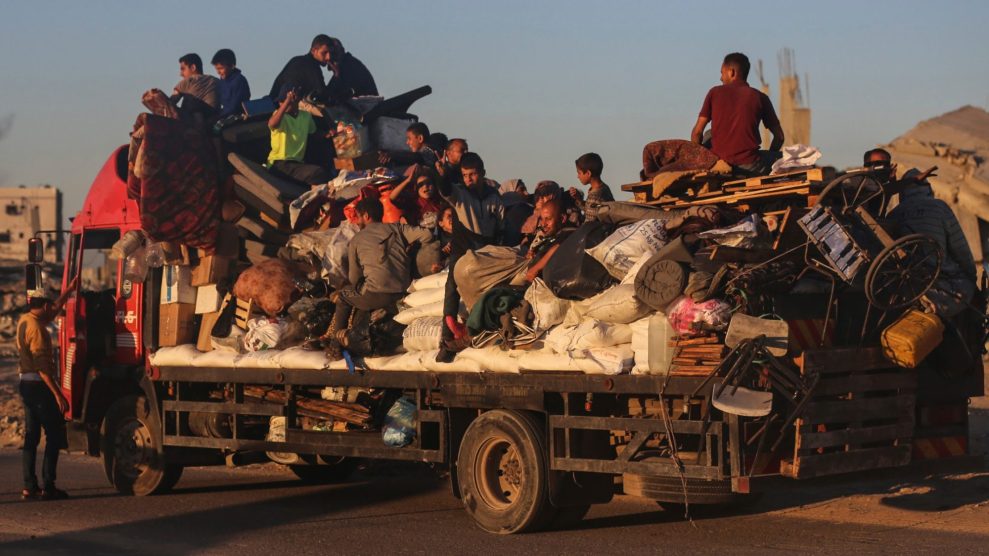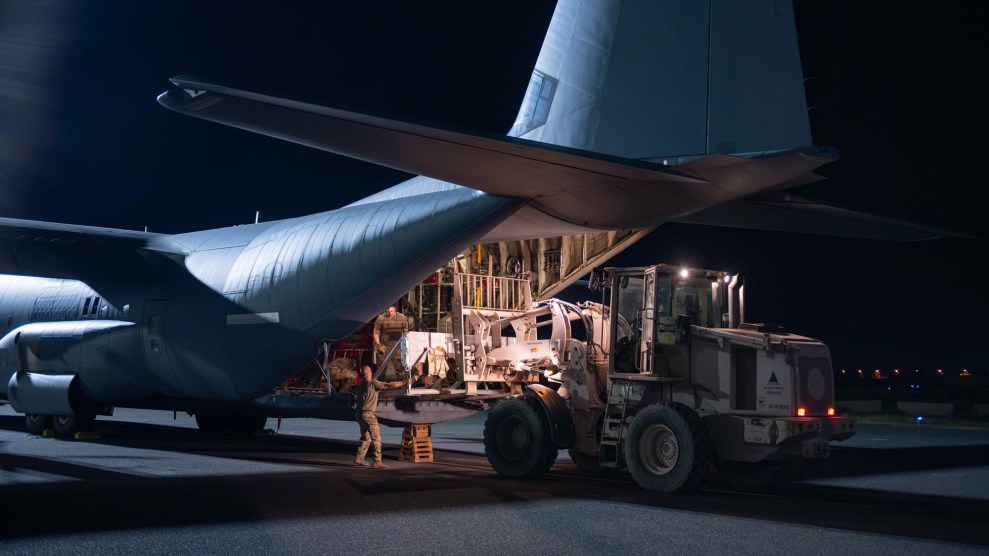
The damaged floating pier, set up by US to facilitate quicker delivery of humanitarian aid to Palestinians, after it has been suspended due to adverse weather conditions.Anadolu/Getty
In early March, President Joe Biden announced that the United States would build a floating pier in the Mediterranean Sea to bring humanitarian aid to Gazans. At the time, the administration heralded it as enabling “a massive increase in the amount of humanitarian assistance getting into Gaza every day.” But last Thursday, Pentagon officials announced that the pier—which was estimated to cost $320 million—would be shut down; despite grand plans, since its installation in May, it has only been operational for about 20 days, according to the Guardian.
The pier represents the counter-productive, unintuitive, and costly way experts say the Biden administration has attempted to get aid to Gaza—a blockaded enclave whose population is “100 percent food insecure” and where many people are experiencing a famine.
The United States has not been able to convince Israel, an ally heavily funded by the US, to cede control of the land crossings into Gaza that most food aid moves through. The pier was designed to circumvent that. But groups like Amnesty International and the World Health Organization said the project fell short compared to land crossings in delivering sorely-needed food and medical aid.
In the weeks that the pier existed, it delivered about 8,500 tons of aid into Gaza—the equivalent of somewhere between 300 and 425 trucks full of food. That is less food aid than the territory used to receive in a single day before the war.
The pier was more of “a way for the Biden Administration to try to look busy,” said Matt Duss, the executive vice president of the Center for International Policy and a former foreign policy adviser to Sen. Bernie Sanders (I-Vt.), than an actual solution.
“I don’t ever want to diminish efforts to get more humanitarian aid to people who desperately need it,” Duss continued. “But there were other things the administration should have been doing to facilitate the delivery of aid that they…continue to refuse to do. [The pier] is essentially a physical symbol of this administration’s ineffectiveness around this war.”
In early May, the Israeli army closed Rafah Crossing, Gaza’s main connection to the outside world, shutting out aid trucks and locking in would-be evacuees. As the IDF bulldozed and occupied the crossing into Egypt, food deliveries into Gaza dropped by two-thirds.
That means right now “more than 34 WHO trucks are waiting in Al Arish and another 40 trucks in Ismailiya in Egypt to cross via Rafah as soon as the border opens,” Dr. Hanan Balkhy, World Health Organization Regional Director for the Eastern Mediterranean, told Mother Jones.
In building the pier, US leaders tried to accomplish two opposing goals at the same time: bypass their own ally’s policies that have caused starvation while avoiding any direct confrontation with Israeli Prime Minister Benjamin Netanyahu’s government.
Dave Harden, the former USAID mission director to the West Bank and Gaza and a former senior Obama adviser, told Mother Jones “the pier was never going to meaningfully solve the humanitarian crisis. The only way to solve the humanitarian crisis is more crossings.”
“[The pier] went through an interagency process, everybody agreed upon it,” Harden said. “It cost $300 million, and it was an absolute failure. So who bears that responsibility?”
The pier was initially connected on May 17th. After a several-week weather-related delay, it was then shut down multiple times due to weather. (The US military had constructed a JLOTS pier, which can only function in pristine conditions.) Each shutdown forced aid delivery to stop for multiple days. And the problems didn’t end there: at one point at the end of May, satellite imagery showed that large portions of the pier had broken off entirely.
The pier’s months of shutdowns and breakdowns made food aid delivery haphazard at best. And, as Duss explained, the deliveries that do make it into Gaza are difficult to distribute due to the sheer scale of infrastructure demolition, as well as the ongoing bombings. Smaller amounts of food aid are still being delivered through Israel’s Kerem Shalom crossing, but news reports say that aid is piling up on the Gaza side of the border without making it to those who need it.
“The problem wasn’t just that people weren’t getting enough aid…it’s that the amount of actual physical destruction in Gaza, which is enormous, just makes it nearly impossible to deliver that aid,” Duss said. “This is done with the complete support of the United States.”
This means the US has enacted legislation to give at least $12.5 billion in military aid to Israel since October 2023 and, on top of that, also given millions in (all too often ineffective) aid to account for Israel’s damage using American weapons.
“The focus should be on opening and maintaining the Rafah border crossing to allow massive, unrestricted flows of aid at the scale that is currently needed,” said WHO’s Hanan Balkhy. “The people of Gaza who have nothing to do with this conflict must not be the ones who pay the price for it.”
















